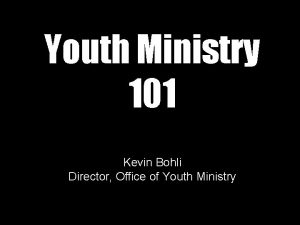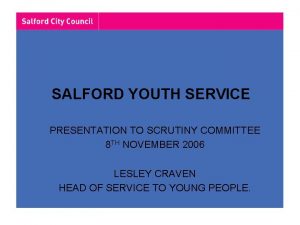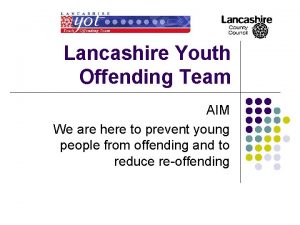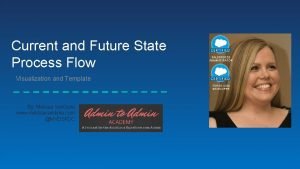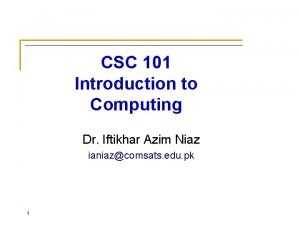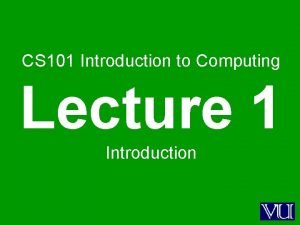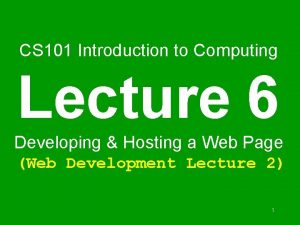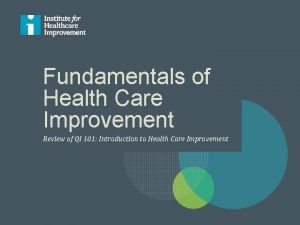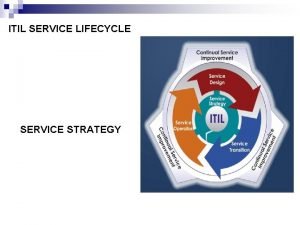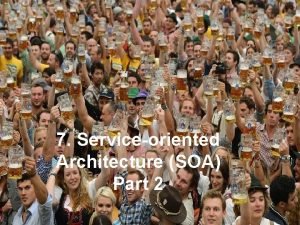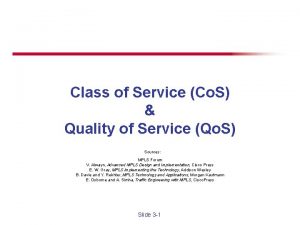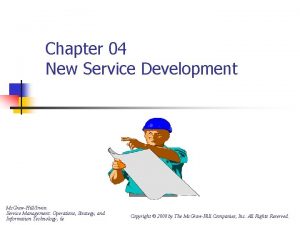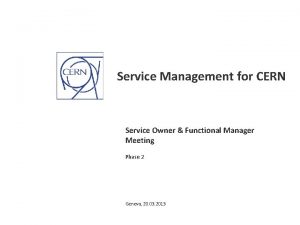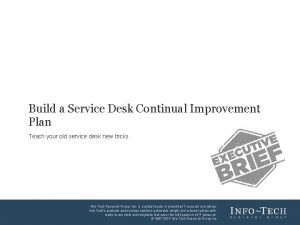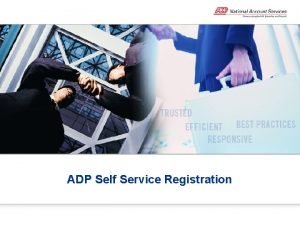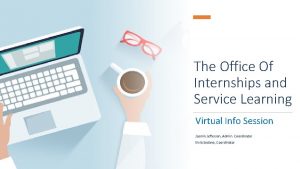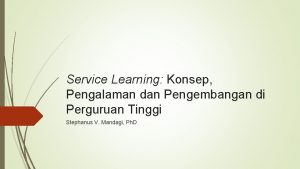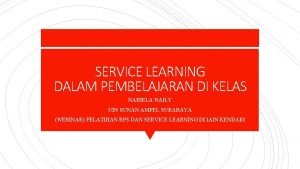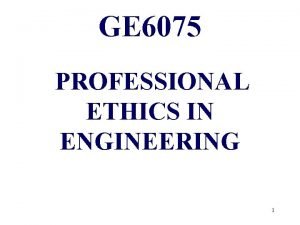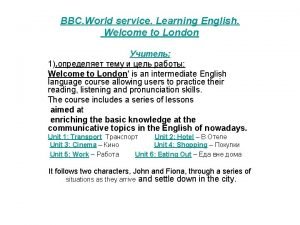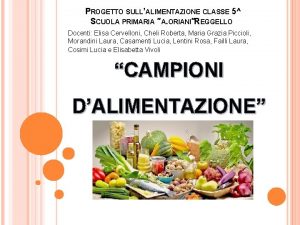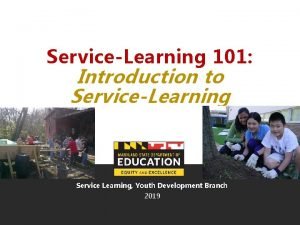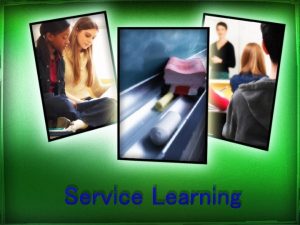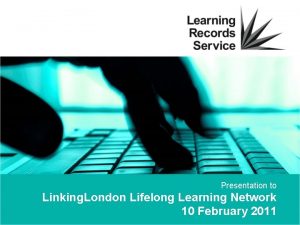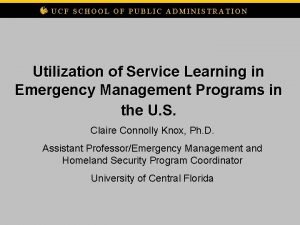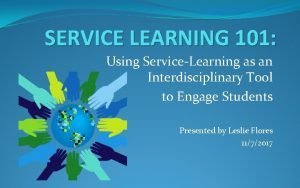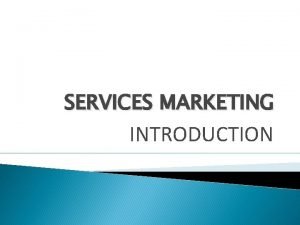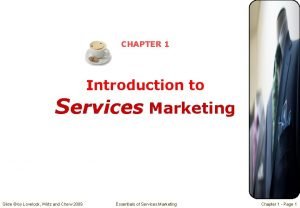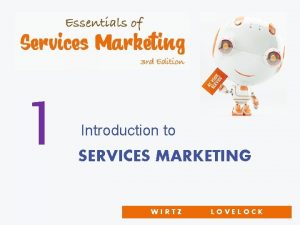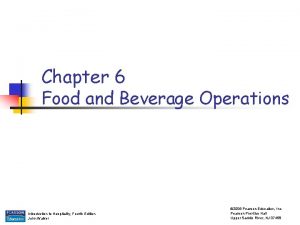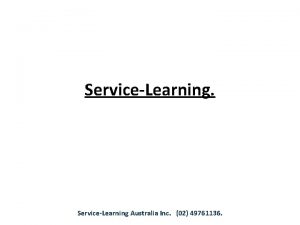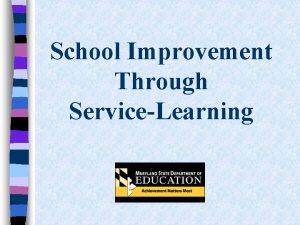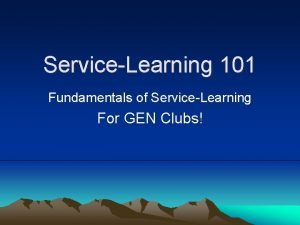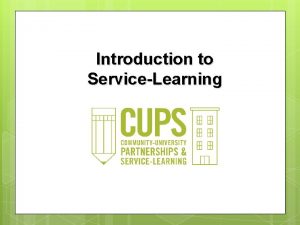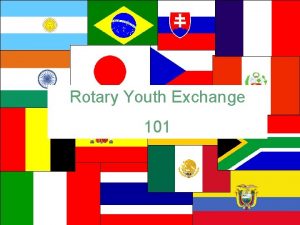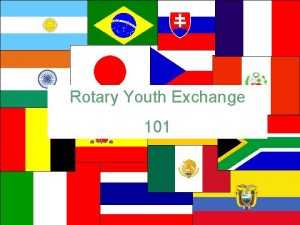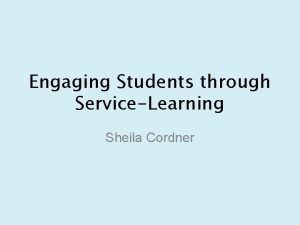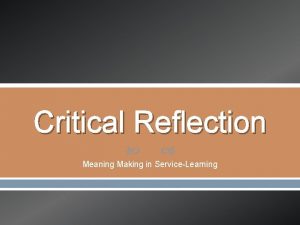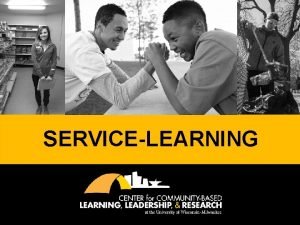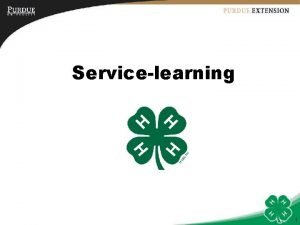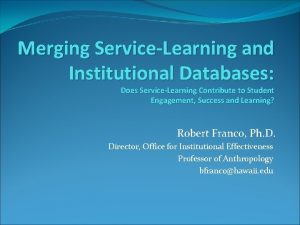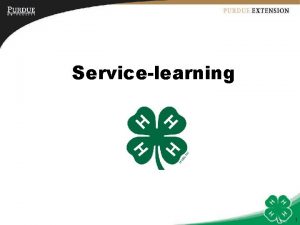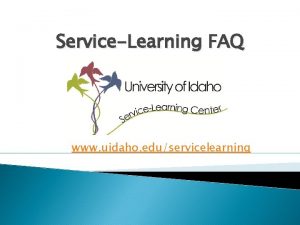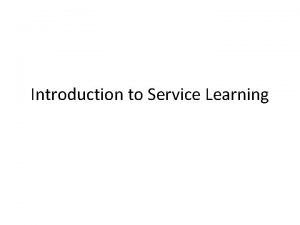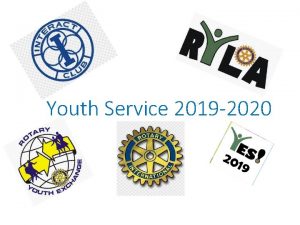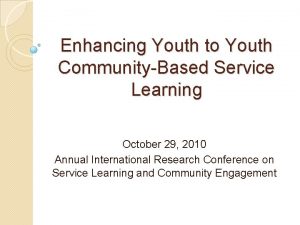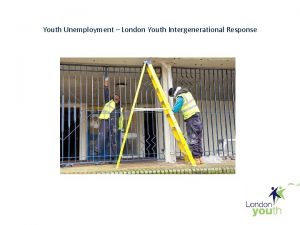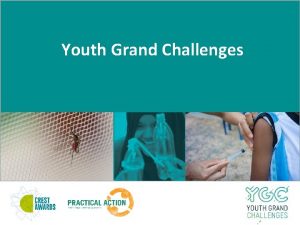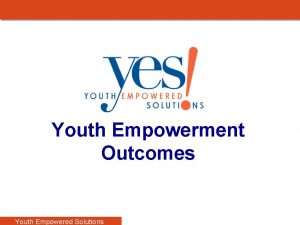ServiceLearning 101 Introduction to ServiceLearning Service Learning Youth


































- Slides: 34

Service-Learning 101: Introduction to Service-Learning Service Learning, Youth Development Branch 2019

Service-Learning 101 2 Introduction to Service-Learning 2019

Service-Learning 101 Agenda 3 • Welcome and Introductions • Goals Review • Definition of Service-Learning • Why Does Maryland do Service-Learning? • History of Service-Learning in Maryland • Standards: Maryland's Seven Best Practices of Service-Learning • Project Planning • Resources • Evaluation Introduction to Service. Learning 2019

Service-Learning 101 Introductions • Facilitator • Participants 4 Introduction to Service. Learning 2019

Stand Up If. . . • You volunteer in your community • You want to learn more about service-learning • You are responsible for your school’s servicelearning program • You do service-learning in your class or school 5

Service-Learning 101 Goal To understand what service-learning means, why it is an effective teaching strategy, and how to create and implement high quality service-learning projects with students. 6

Service-Learning Mission It is the mission of the Service-Learning Office to institutionalize high quality service-learning for students in all Maryland K 12 public schools, and to encourage its application in schools across the United States. 7

How wonderful is it that nobody need wait a single moment before starting -- Anne Frank to improve the world. 8

Definitions Discuss the similarities and differences between each of these terms. • Community Service • Volunteerism • Internship • Service-Learning 9

Service-Learning Service-learning is a teaching method that combines meaningful service to the community with curriculumbased learning. 10 Students improve their academic skills by applying what they learn in school to the real world; they then reflect on their experience to reinforce the link between their service and their learning. Learning in Deed

Lecture Reading Audio-Visual Demonstration Discussion Group Practice By Doing Teach Others/Immediate Use of Learning 11

Impact of Service-Learning The Corporation for National and Community Service has compiled research that shows students who engage in service-learning experiences have: • Improved Academic Achievement • Improved Academic Engagement • Positive Civic Attitudes and Behaviors • Enhanced Social and Personal Skills 12

Brandeis University Service-Learning Study Results • Benefited a wide range of youth • Improved academic achievement • Helped students learn useful skills • Resulted in positive impact on certain risk behaviors 13

History of Service-Learning In Maryland • 1982 - The book, High School, by Ernest Boyer advocates for a new Carnegie Unit for mandatory service. • Early 1980’s - David Hornbeck, Maryland’s Superintendent at the time, visit Israel and sees service in schools in action. • 1983 -84 - Hornbeck vigorously encourages the State Board of Education to adopt a service requirement for all students. • 1985 - State Board adopts an optional service opportunity for students. 14

History Continued - 2 • 1988 -92 - Technical assistance provided to teachers and schools in servicelearning. • 1992 - State Board adopts current mandatory service requirement impacting the class of 1997. • 1993 - Learn and Serve America (LSA) subgrants given to local school systems (LSS). • 1993 – First class of Service-Learning Fellows inducted by MSDE. • 1995 - Maryland’s Best Practices: An Improvement Guide for School-Based Service-Learning is released. 15

History Continued -3 • Winter 1997 – Service-Learning website is created with information on local, state, and national service-learning programs and issues. • October 2000 - "Statewide Quality Review" initiative begins with MSDE specialists visiting every school district during the school year to monitor service-learning implementation policies and assess quality of service-learning activities. • September 2001 - State Department of Education forms new "Youth Development Branch" combining service-learning, character education, out of school learning, and student government programs into a single strategic entity. The Branch is part of the Division of Student Support, Academic Enrichment, and Educational Policy. 16

History Continued 4 • 2004 – LSS submit their service-learning implementation plans for a 10 year review by a panel of experts and an every four year Quality Review Cycle begins (2004, 2008, 2012, 2016…). • 2007 – Sample service-learning units developed by teachers that link to Maryland standards. • 2008 – National standards for service-learning created which align with Maryland’s 7 Best Practices of Service-Learning. • 2011 – Learn and Serve America funding eliminated from Federal budget. • Present – MSDE provides a vast amount of resources through the website to support LSS, teachers, students, and community based organizations with service-learning. 17

COMAR Regulation 13 A. 03. 02. 05 · · Students shall complete one of the following: 75 hours of student service that includes preparation, action, and reflection components and that, at the discretion of the local school system, may begin during the middle grades; or A locally designed program of student service that has been approved by the State Superintendent of Schools. 18

Service-Learning in Maryland • Infused in a course • Interdisciplinary Projects • Service-Learning Courses • Independent Projects • Clubs & Activities 19

The Seven Best Practices of Service-Learning 1. Meet a recognized need in the community 2. Achieve curricular objectives through service-learning 3. Reflect throughout the servicelearning experience 4. Develop student responsibility 5. Establish community partnerships 6. Plan ahead for service-learning 7. Equip students with knowledge and skills needed for service 20

7 Best Practice Window Pane Activity Instructions for this interactive activity found in The Training Toolbox: A Guide to Service-Learning Training, Appendix, handout 9 -10. 21

Direct Service Tutoring, Mentoring, Visiting the Elderly Students Learn: • To be responsible for their • • • 22 own actions To be dependable To make a difference in another person’s life To solve problems To care for another person To focus on the needs of others, and put one’s own problems in context • To get along with people different from one’s self

Indirect Service Drives, Collections, Fund Raisers, Clean Ups, Construction, Environmental Students Learn: • To work in a team and • To involve others cooperate (recruit them to • To play different roles in a help) group • To perform project • To take pride in an specific skills accomplishment • To value working • To organize people to get with others to solve a job done problems 23

Advocacy Lobbying, Speaking, Performing 24 • To persevere • To articulate a concern and suggest solutions • To persuade people to act in a new way • To understand relationships among issues • To appreciate the duties and privileges of citizenship • To appreciate the political process

Reflection • To explore the impact and importance of citizen service to the community • To understand how to learn from experience • To develop a language of caring and commitment • To instill habits of participation as an expectation of citizenship 25

Reflection Tips • Attend to broader issues as well as personal experience • Encourage creativity • Use diverse activities • Have students structure some of the reflection sessions • Engage students in multiple reflection activities throughout the duration of the project 26

You make a living by what you get. You make a life by what you give. - Winston Churchill 27

Meeting State Curriculum Objectives through Service-Learning 28

Service-Learning Units Aligned with the Maryland State Curriculum • 15 sample service-learning experiences linked to Maryland curriculum that were created by teachers. These projects are embedded in a variety of different content areas and grade levels and are easily adaptable to local school system needs. (http: //marylandpublicschools. org/programs/Pages /Service. Learning. Units/SLUnits. aspx) 29 • 14 sample service-learning experiences created for special education students and linked to Maryland curriculum that were created by teachers from around the State. (http: //marylandpublicschools. org/programs/Pages/S ervice. Learning/Service. Learning. Units/SPEDSLUnits. aspx)

Native Species Restoration 30

Project Walk Through Creating a Sample Project Together 1. What community need could your project address? 2. What curricular objectives could the project meet? 3. How would students reflect throughout the experience? 4. How could student responsibility and leadership be developed through the project? 31 7. How would you equip students with the knowledge and skills needed for the project and regarding civic participation? 6. How would you plan ahead for the project? What assessment would you use to evaluate student learning and community impact? 5. Who would be community partners on the project?

Resources n n n MSDE’s Website at www. mdservicelearning. org MSDE Materials (Service. Learning Guidelines, Interdisciplinary Webs, 7 Best Practice Guide…) MSDE Staff at 410 -7670357 32

Feedback/Evaluation Plus 33 Delta

You cannot do a kindness too soon, for you never know how soon it will be too late. - Ralph Waldo Emerson 34
 Youth ministry 101
Youth ministry 101 Cuadro comparativo e-learning m-learning b-learning
Cuadro comparativo e-learning m-learning b-learning Salford youth service
Salford youth service Youth offending service
Youth offending service Ihi l 101
Ihi l 101 Current state vs future state slide
Current state vs future state slide It 101 - introduction to computing
It 101 - introduction to computing It 101 - introduction to computing
It 101 - introduction to computing Cs101 vu edu pk
Cs101 vu edu pk Qi 101: introduction to health care improvement
Qi 101: introduction to health care improvement Phases in itil life cycle
Phases in itil life cycle What is the purpose of the service strategy lifecycle stage
What is the purpose of the service strategy lifecycle stage Csi 7 step improvement process
Csi 7 step improvement process Factors that influence customer expectations of service
Factors that influence customer expectations of service Evolution of soa
Evolution of soa Mpls class of service
Mpls class of service New service concept design
New service concept design Service owner vs service manager
Service owner vs service manager Help desk improvement plan
Help desk improvement plan Adp self serve portal
Adp self serve portal Service learning csusm
Service learning csusm Contoh service learning
Contoh service learning Contoh service learning
Contoh service learning Objectives of professional ethics
Objectives of professional ethics Bbc world service learning english
Bbc world service learning english Progetto alimentazione scuola primaria classe terza
Progetto alimentazione scuola primaria classe terza Msde service learning
Msde service learning Characteristics of service learning
Characteristics of service learning Olass - offender learning and skills service
Olass - offender learning and skills service Ucf public administration masters
Ucf public administration masters 5 stages of service learning
5 stages of service learning Servuction model
Servuction model Forces transforming the service economy
Forces transforming the service economy Introduction of service marketing
Introduction of service marketing Introduction to food and beverage service department
Introduction to food and beverage service department
